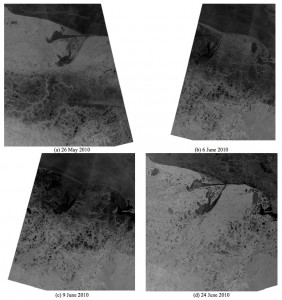by our staff writers
July 25, 2013
The following images illustrate the strong responses seen in radar backscatter data when the winter snow melts in the region, usually in late May and June. The data shown below was acquired by the ASAR sensor on the ENVISAT satellite in 2010. The data was acquired using the sensor’s “wide swath” (WS) ScanSAR mode, whereby beams are subsequently scanned across the landscape, enabling large areas to be covered in a single acquisition. The region shown is approximately 317km by 332km in size. ASAR WS medium resolution products were used, provided with a native 75m sample interval (150m resolution) in ground range geometry (azimuth and cross-range directions). The datasets were radiometrically calibrated using standard models and then geometrically terrain corrected using the SRTM30 1km resolution height model presented in a UTM map projection. The region is relatively flat, with some undulations visible in the southeast that could benefit from the use of a higher quality height model. Some small radiometric artefacts aligned in the satellite path (azimuth) direction are visible at the beam-boundaries due to the ScanSAR acquisition methodology. However, much stronger variations are caused by land cover changes taking place between the different acquisition dates. Dark backscatter indicates wet snow, while higher values can derive either from dry snow or snow-free land cover. Note how the melting begins in the south, progressing slowly northwards until there is none left by late June. The upcoming Sentinel-1 series of satellites, the first of which is due to be launched in early 2014, will be able to provide such observations with spatial and temporal resolutions both improved with respect to what was possible using ENVISAT ASAR.

